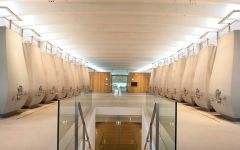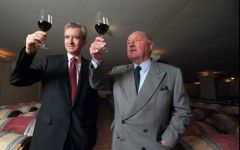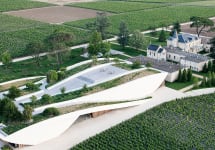Chateau Cheval Blanc 1982
-
Robert
Parker -
James
Suckling -
Wine
Spectator -
Jeb
Dunnuck -
Robert
Parker



Product Details
Your Rating
Somm Note
Winemaker Notes
The beautiful color is medium-deep and showing some bricking on the rim. The nose is remarkably powerful, concentrated, and complex with an elegant succession of truffle, crème caramel, and prune aromas, as well as a slight smokiness. When swirled in the glass, the bouquet goes on to reveal roasted overtones of coffee, cocoa, and chocolate overlaying spice (cinnamon) and praline. The wine starts out smooth, fresh and rich on the palate. It is rich, concentrated, round, and sinewy on the palate, but also fluid and in no way heavy. The velvety tannin is accompanied by flavors of cedar and blackcurrant, accompanied by blackberry and raspberry jam nuances that go into a very long aftertaste. This wine seems virtually eternal and still has the attributes of its flamboyant youth.
Professional Ratings
-
Robert Parker's Wine Advocate
The 1982 Cheval Blanc is a sumptuous, sensual wine, bursting with aromas of sweet raspberries, orange rind, dried flowers, cedar box, black truffles, vine smoke and menthol. Medium to full-bodied, ample and enveloping, it's supple and seamless, with a fleshy mid-palate, melting tannins and a long, expansive finish. As is often the case at this address, at age 40, it's the wine's Cabernet Franc component that really dominates its personality, meaning that it gratifies the intellect as completely as it does the senses.
-
James Suckling
This stuck out in the blind tasting as the odd bottle out due to the high percentage of Cabernet Franc in the blend. It was more like Burgundy on the nose with sliced plums, strawberries and peaches that turn to tropical fruits and chocolate and flowers. It's full-bodied with a very round texture and velvety tannins. This is so approachable and enticing. Soft and voluptuous wine.
-
Wine Spectator
All in harmony. Deserves its reputation. Dark ruby. Smoke, black truffle, berry and cherry. Full-bodied, velvety and fine.-
-
Jeb Dunnuck
The 1982 Chateau Cheval Blanc is fully mature at this point and there’s certainly no upside, although it should keep for a decade. Mature red and black fruits, cedary spices, leather, flowers and dried flowers all flow to a sweetly fruited, sexy, open knit and ready to go wine that has resolved tannin and a good finish.
-
Robert Parker's Wine Advocate
During its first 10-12 years of life, this was a perfect wine, but it now seems to be in a stage where the fruit is still present, but the previous exuberance and intensity have faded slightly. There is plenty of amber at the edge, and this medium to full-bodied wine shows notes of menthol, cedar, spice box, plums, and black cherries.
Other Vintages
2022- Decanter
-
James
Suckling - Vinous
-
Robert
Parker -
Jeb
Dunnuck
- Vinous
-
James
Suckling -
Robert
Parker -
Wine
Enthusiast - Decanter
-
Jeb
Dunnuck
-
Jeb
Dunnuck -
James
Suckling - Decanter
-
Wine
Enthusiast -
Wine
Spectator -
Robert
Parker
-
Robert
Parker -
James
Suckling - Decanter
-
Wine
Spectator
- Decanter
-
James
Suckling -
Jeb
Dunnuck -
Wine
Enthusiast -
Robert
Parker -
Wine
Spectator
-
James
Suckling -
Robert
Parker -
Jeb
Dunnuck -
Wine
Spectator - Decanter
-
Wine
Enthusiast
-
Robert
Parker -
James
Suckling - Decanter
-
Wine
Enthusiast -
Jeb
Dunnuck -
Wine
Spectator
-
Robert
Parker -
Wine
Enthusiast -
James
Suckling -
Wine
Spectator - Decanter
-
Jeb
Dunnuck
-
Wine
Spectator -
Robert
Parker -
Wine
Enthusiast -
James
Suckling -
Jeb
Dunnuck
-
Jeb
Dunnuck -
Wine
Spectator -
Wine
Enthusiast -
James
Suckling -
Robert
Parker
-
Jeb
Dunnuck -
Robert
Parker -
Wine
Spectator -
James
Suckling -
Wine
Enthusiast
-
Wine
Enthusiast -
James
Suckling -
Jeb
Dunnuck -
Robert
Parker -
Wine
Spectator
-
Jeb
Dunnuck -
Robert
Parker -
James
Suckling -
Wine
Enthusiast -
Wine
Spectator
-
Robert
Parker -
Wine
Enthusiast -
Wine
Spectator
-
Wine
Enthusiast -
Robert
Parker -
Wine
Spectator -
Wine &
Spirits
-
Jeb
Dunnuck -
Robert
Parker -
James
Suckling -
Wine
Spectator -
Wine
Enthusiast -
Wine &
Spirits
-
Wine
Enthusiast -
Wine
Spectator
-
Wine
Spectator -
Wine
Enthusiast -
Robert
Parker
-
Wine
Spectator -
Robert
Parker
-
Wine &
Spirits -
Robert
Parker -
Wine
Spectator
-
Robert
Parker -
Jeb
Dunnuck -
Wine
Enthusiast -
Wine &
Spirits -
Wine
Spectator
-
Robert
Parker
- Decanter
-
Jeb
Dunnuck -
Wine
Spectator -
Robert
Parker -
James
Suckling -
Wine &
Spirits
-
Wine
Spectator
-
Wine
Spectator
-
Robert
Parker -
James
Suckling -
Wine
Spectator
- Vinous
-
Robert
Parker
-
Wine
Spectator
-
Wine
Spectator
-
Wine
Spectator






The present-day Cheval Blanc vineyards had vines at least as far back as the 18th century, as shown by Belleyme's map of the region dated 1764. Nearly a century later, the estate was acquired by the Fourcaud-Laussac family who owned it until 1998, when it was sold to Mr Bernard Arnault and Baron Albert Frère.
The vineyard is in a single block, and borders on the Pomerol appellation. An outstanding terror and unusual proportions of Cabernet Franc and Merlot give this great wine an absolutely unique flavor. Chateau Cheval Blanc has had a greater number of outstanding vintages than any other classified great growth over the past century.
Another unusual characteristic of Cheval Blanc is that once it reaches its peak, it maintains it for a very long time. This admirable wine is powerful, soft, rich, round and silky. It has tremendous fruit and elegance as well as exceptional quality from year to year.

One of the world’s most classic and popular styles of red wine, Bordeaux-inspired blends have spread from their homeland in France to nearly every corner of the New World. Typically based on either Cabernet Sauvignon or Merlot and supported by Cabernet Franc, Malbec and Petit Verdot, the best of these are densely hued, fragrant, full of fruit and boast a structure that begs for cellar time. Somm Secret—Blends from Bordeaux are generally earthier compared to those from the New World, which tend to be fruit-dominant.

Marked by its historic fortified village—perhaps the prettiest in all of Bordeaux, the St-Émilion appellation, along with its neighboring village of Pomerol, are leaders in quality on the Right Bank of Bordeaux. These Merlot-dominant red wines (complemented by various amounts of Cabernet Franc and/or Cabernet Sauvignon) remain some of the most admired and collected wines of the world.
St-Émilion has the longest history in wine production in Bordeaux—longer than the Left Bank—dating back to an 8th century monk named Saint Émilion who became a hermit in one of the many limestone caves scattered throughout the area.
Today St-Émilion is made up of hundreds of independent farmers dedicated to the same thing: growing Merlot and Cabernet Franc (and tiny amounts of Cabernet Sauvignon). While always roughly the same blend, the wines of St-Émilion vary considerably depending on the soil upon which they are grown—and the soils do vary considerably throughout the region.
The chateaux with the highest classification (Premier Grand Cru Classés) are on gravel-rich soils or steep, clay-limestone hillsides. There are only four given the highest rank, called Premier Grand Cru Classés A (Chateau Cheval Blanc, Ausone, Angélus, Pavie) and 14 are Premier Grand Cru Classés B. Much of the rest of the vineyards in the appellation are on flatter land where the soils are a mix of gravel, sand and alluvial matter.
Great wines from St-Émilion will be deep in color, and might have characteristics of blackberry liqueur, black raspberry, licorice, chocolate, grilled meat, earth or truffles. They will be bold, layered and lush.
